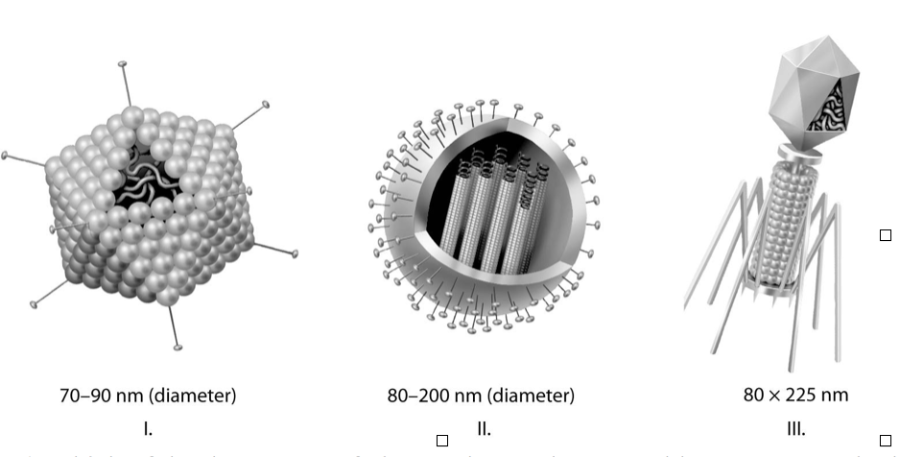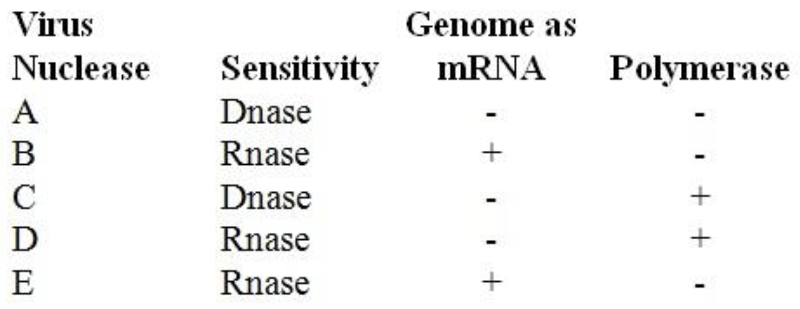Instructions for Side by Side Printing
- Print the notecards
- Fold each page in half along the solid vertical line
- Cut out the notecards by cutting along each horizontal dotted line
- Optional: Glue, tape or staple the ends of each notecard together
Campbell Biology Chapter 19 (powell_h)
front 1 1) Viral genomes vary greatly in size and may include from four genes
to several hundred genes. Which of the following viral features is
most apt to correlate with the size of the genome? | back 1 Answer: D |
front 2 2) Viral envelopes can best be analyzed with which of the following
techniques? | back 2 Answer: B |
front 3 3) The host range of a virus is determined by | back 3 Answer: E |
front 4 4) Most human-infecting viruses are maintained in the human
population only. However, a zoonosis is a disease that is transmitted
from other vertebrates to humans, at least sporadically, without
requiring viral mutation. Which of the following is the best example
of a zoonosis? | back 4 Answer: A |
front 5 5) Which of the following accounts for someone who has had a
herpesvirus-mediated cold sore or genital sore getting flare-ups for
the rest of his or her life? | back 5 Answer: D |
front 6 6) In many ways, the regulation of the genes of a particular group of
viruses will be similar to the regulation of the host genes.
Therefore, which of the following would you expect of the genes of the
bacteriophage? | back 6 Answer: C |
front 7 7) Which of the following is characteristic of the lytic cycle?
| back 7 Answer: D |
front 8 8) Which of the following statements describes the lysogenic cycle of
lambda (λ) phage? | back 8 Answer: C |
front 9 9) Why do RNA viruses appear to have higher rates of
mutation? | back 9 Answer: B |
front 10 10) Most molecular biologists think that viruses originated from
fragments of cellular nucleic acid. Which of the following
observations supports this theory? | back 10 Answer: E |
front 11 11) A researcher lyses a cell that contains nucleic acid molecules
and capsomeres of tobacco mosaic virus (TMV). The cell contents are
left in a covered test tube overnight. The next day this mixture is
sprayed on tobacco plants. Which of the following would be expected to
occur? | back 11 Answer: C |
front 12 12) Which viruses have single-stranded RNA that acts as a template
for DNA synthesis? | back 12 Answer: E |
front 13 13) What is the function of reverse transcriptase in retroviruses?
| back 13 Answer: B |
front 14 14) Which of the following can be effective in preventing the onset
of viral infection in humans? | back 14 Answer: B |
front 15 15) Which of the following describes plant virus infections? | back 15 Answer: B |
front 16 16) Which of the following represents a difference between viruses
and viroids? | back 16 Answer: B |
front 17 17) The difference between vertical and horizontal transmission of
plant viruses is that | back 17 Answer: A |
front 18 18) What are prions? | back 18 Answer: D |
front 19 19) Which of the following is the best predictor of how much damage a
virus causes? | back 19 Answer: A |
front 20 20) Antiviral drugs that have become useful are usually associated
with which of the following properties? | back 20 Answer: B |
front 21 21) Which of the following series best reflects what we know about
how the flu virus moves between species? | back 21 Answer: E |
front 22 22) Which of the following is the most probable fate of a newly
emerging virus that causes high mortality in its host? | back 22 Answer: E |
front 23  23) Which of the three types of viruses shown above would you expect
to include glycoproteins? | back 23 Answer: D |
front 24  24) Which of the three types of viruses shown above would you expect
to include a capsid(s)? | back 24 Answer: E |
front 25  25) In the figure, at the arrow marked II, what enzyme(s) are being
utilized? | back 25 Answer: C |
front 26  26) In the figure, when new viruses are being assembled (IV), what
mediates the assembly? | back 26 Answer: E |
front 27  27) A linear piece of viral DNA of 8 kb can be cut with either of two
restriction enzymes (X or Y). These are subjected to electrophoresis
and produce the following bands: | back 27 Answer: B |
front 28 Some viruses can be crystallized and their structures analyzed. One
such virus is Desmodium, or yellow mottle virus, which infects beans.
This is a member of the tymovirus group and has a single-stranded RNA
genome of ~6,300 nucleotides. Its virion is 25—30 nm in diameter, and
is made up of 180 copies of a single capsid protein that
self-associate to form each capsomere, which has icosahedral symmetry
with 20 facets. | back 28 Answer: C |
front 29 Some viruses can be crystallized and their structures analyzed. One
such virus is Desmodium, or yellow mottle virus, which infects beans.
This is a member of the tymovirus group and has a single-stranded RNA
genome of ~6,300 nucleotides. Its virion is 25—30 nm in diameter, and
is made up of 180 copies of a single capsid protein that
self-associate to form each capsomere, which has icosahedral symmetry
with 20 facets. | back 29 Answer: E |
front 30 Some viruses can be crystallized and their structures analyzed. One
such virus is Desmodium, or yellow mottle virus, which infects beans.
This is a member of the tymovirus group and has a single-stranded RNA
genome of ~6,300 nucleotides. Its virion is 25—30 nm in diameter, and
is made up of 180 copies of a single capsid protein that
self-associate to form each capsomere, which has icosahedral symmetry
with 20 facets. | back 30 Answer: C |
front 31 Some viruses can be crystallized and their structures analyzed. One
such virus is Desmodium, or yellow mottle virus, which infects beans.
This is a member of the tymovirus group and has a single-stranded RNA
genome of ~6,300 nucleotides. Its virion is 25—30 nm in diameter, and
is made up of 180 copies of a single capsid protein that
self-associate to form each capsomere, which has icosahedral symmetry
with 20 facets. | back 31 Answer: B |
front 32 Poliovirus is a positive-sense RNA virus of the picornavirus group.
At its 5' end, the RNA genome has a viral protein (VPg) instead of a
5' cap. This is followed by a nontranslated leader sequence, and then
a single long protein coding region (~7,000 nucleotides), followed by
a poly-A tail. Observations were made that used radioactive amino acid
analogues. Short period use of the radioactive amino acids result in
labeling of only very long proteins, while longer periods of labeling
result in several different short polypeptides. | back 32 Answer: C |
front 33 Poliovirus is a positive-sense RNA virus of the picornavirus group.
At its 5' end, the RNA genome has a viral protein (VPg) instead of a
5' cap. This is followed by a nontranslated leader sequence, and then
a single long protein coding region (~7,000 nucleotides), followed by
a poly-A tail. Observations were made that used radioactive amino acid
analogues. Short period use of the radioactive amino acids result in
labeling of only very long proteins, while longer periods of labeling
result in several different short polypeptides. | back 33 Answer: C |
front 34  In 1971, David Baltimore described a scheme for classifying viruses
based on how the virus produces mRNA. | back 34 Answer: B |
front 35  In 1971, David Baltimore described a scheme for classifying viruses
based on how the virus produces mRNA. | back 35 Answer: D |
front 36  In 1971, David Baltimore described a scheme for classifying viruses
based on how the virus produces mRNA. | back 36 Answer: A |
front 37 You isolate an infectious substance that is capable of causing
disease in plants, but you do not know whether the infectious agent is
a bacterium, virus, viroid, or prion. You have four methods at your
disposal that you can use to analyze the substance in order to
determine the nature of the infectious agent. | back 37 Answer: A |
front 38 You isolate an infectious substance that is capable of causing
disease in plants, but you do not know whether the infectious agent is
a bacterium, virus, viroid, or prion. You have four methods at your
disposal that you can use to analyze the substance in order to
determine the nature of the infectious agent. | back 38 Answer: C |
front 39 You isolate an infectious substance that is capable of causing
disease in plants, but you do not know whether the infectious agent is
a bacterium, virus, viroid, or prion. You have four methods at your
disposal that you can use to analyze the substance in order to
determine the nature of the infectious agent. | back 39 Answer: D |
front 40 The herpes viruses are very important enveloped DNA viruses that
cause disease in all vertebrate species and in some invertebrates such
as oysters. Some of the human ones are herpes simplex (HSV) I and II,
causing facial and genital lesions, and the varicella-zoster (VSV),
causing chicken pox and shingles. Each of these three actively infect
nervous tissue. Primary infections are fairly mild, but the virus is
not then cleared from the host; rather, viral genomes are maintained
in cells in a latent phase. The virus can then reactivate, replicate
again, and be infectious to others. | back 40 Answer: B |
front 41 The herpes viruses are very important enveloped DNA viruses that
cause disease in all vertebrate species and in some invertebrates such
as oysters. Some of the human ones are herpes simplex (HSV) I and II,
causing facial and genital lesions, and the varicella-zoster (VSV),
causing chicken pox and shingles. Each of these three actively infect
nervous tissue. Primary infections are fairly mild, but the virus is
not then cleared from the host; rather, viral genomes are maintained
in cells in a latent phase. The virus can then reactivate, replicate
again, and be infectious to others. | back 41 Answer: D |
front 42 The herpes viruses are very important enveloped DNA viruses that
cause disease in all vertebrate species and in some invertebrates such
as oysters. Some of the human ones are herpes simplex (HSV) I and II,
causing facial and genital lesions, and the varicella-zoster (VSV),
causing chicken pox and shingles. Each of these three actively infect
nervous tissue. Primary infections are fairly mild, but the virus is
not then cleared from the host; rather, viral genomes are maintained
in cells in a latent phase. The virus can then reactivate, replicate
again, and be infectious to others. | back 42 Answer: C |
front 43 43) Which of the following characteristics, structures, or processes
is common to both bacteria and viruses? | back 43 Answer: C |
front 44 44) Emerging viruses arise by | back 44 Answer: D |
front 45 45) To cause a human pandemic, the H5N1 avian flu virus would have to
| back 45 Answer: C |
front 46 46) A bacterium is infected with an experimentally constructed
bacteriophage composed of the T2 phage protein coat and T4 phage DNA.
The new phages produced would have | back 46 Answer: D |
front 47 47) RNA viruses require their own supply of certain enzymes because
| back 47 Answer: B |